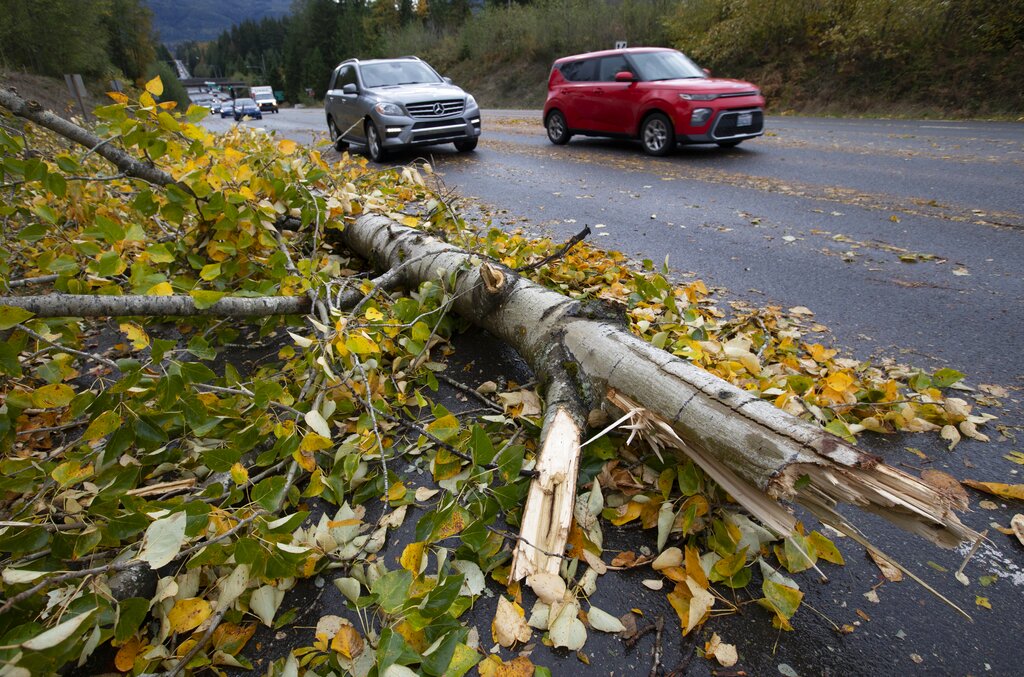Tom Hinckley kicked through leaves on a sopping morning at the Washington Park Arboretum.
The rain made the trees’ autumn colors shine with wet, and their trunks dark as lead set in glowing stained glass.
Lovely as they are, all those leaves still on the trees can spell trouble in storms that have hit with unusual strength so early in the fall, said Hinckley, professor emeritus at the University of Washington School of Environmental and Forest Sciences.
Windstorms can be far more damaging to trees when they come, as the “bomb cyclone” that hit last weekend did, while leaves are still thick on the trees.
In this most recent howler, winds on the coast gusted into the 50 mph range and even topped 70 mph just over the Washington border near Astoria, Oregon, on Sunday. Inland, gusts were clocked at 40 to 50 mph from Boeing Field to the San Juan Islands, said Mary Butwin, a meteorologist at the National Weather Service in Seattle.
The Olympic Peninsula was soaked with 5 inches of rain from midnight Saturday to midnight Tuesday. Nearly 8 inches of rain fell in the southeastern Olympic Peninsula.
It is starting to be the season for these storms to blow in. But the recent ruckus was on the earlier side, Butwin said. Thanksgiving weekend usually marks the beginning of the windstorms here.
The combination of lots of rain, microbursts of wind and leaves is a doozy; trees are not built for that kind of punishment.
“When the leaves are on, the canopy acts more like a sail; it catches the wind,” said Dave Bayard. He is in charge of what utility Seattle City Light calls its “veg management unit” — the crews who deal with trees in the path of power lines.
“We get a lot more damage when the leaves are still on,” said Bayard, adding that the year-after-year drought has also been taking its toll on the trees, limiting their ability to grow wood to reinforce stress points.
“They only have so much they can put into their defenses, and that is a trend we have been seeing for a number of years.”
Trees can be surprisingly shallow-rooted, with roots spreading wide, rather than deep, in a big pancake in the top inches of the soil.
This makes sense from the tree’s perspective. Most of the nutrients are in the top level of the soil, in the leaf litter and minerals, and a vasculature of fungal threads that carry moisture and nutrition from tree to tree.
However, that also means that when soils are either saturated with rain already, or still powdery from drought, a rushing sky river of wind and rain can be a recipe for damage.
Trees are marvels of engineering, built to take a life of abuse while, well, rooted in place.
The late Steven Vogel, biologist, biomechanics pioneer and longtime professor at Duke University, spent his career analyzing how leaves manage wind and sun.
He discovered in wind-tunnel experiments chronicled in his book “The Life of a Leaf” (Chicago, 2012) that leaves and pine needles are engineered to cluster and curl in the wind, to reduce the forces of drag. But trees are built for ordinary, not extraordinary risks.
There also always is more to how a given tree will respond in a storm than meets the eye in that moment.
Trees are scribes of their environment, their wood and growth responding to all that goes on around them over time.
Like people, each tree’s version of history will be a little different. There are commonalities in any one place, but trees respond to events as individuals, reflecting their specific site and life story.
“They have all this history built into them; when a tree falls over it’s a combination of the moment now, and its history,” Hinckley said.
Tree failure can be catastrophic. A woman and her 22-year-old son were killed by a falling tree Sunday as they drove on Preston-Fall City Road.
The bomb cyclone was so extreme it caused tree and power line damage the utility is still cleaning up. Broken branches are hung up in trees, just waiting to shake out in the next storm.
“There were localized pockets of pretty intense wind bursts,” Bayard said. “You take a tree that is accustomed to bending a certain amount and you force it to do much more, and that is when you get a failure.”
But if anything, Bayard said, he is amazed at what trees can take.
“It is amazing to watch this 100-foot cottonwood, branches all akimbo, moving 30, 40 feet, side to side. For the most part, stuff stays put.
“It is worth taking a second look around at how much really tall trees did not blink at this, because of how they move.”
The oldest trees have had to master a tremendous amount of environmental change, including the loss of management regimes practiced by the first peoples of the region, Hinckley noted.
Development also has created fragmented, patchy groves, where there once were forests in which acres of trees could buttress one another in the wind.
New plantings in subdivisions never put on the strength they need if left staked, or sheltered from the wind by buildings.
Like people, trees must endure adversity to get strong. Trees will push food to an area that is stressed to put on additional wood just where it is needed — but the signal to do so is induced by movement in wind.
“It toughens up at the stress point. They depend on wind to have girth,” Hinckley said.
Another atmospheric river is flowing overhead this week. But it is much weaker than the last one, with breezy winds forecast to back down to gusts of 20 mph or so by Friday.
Nothing out of the usual tempest for these parts, Butwin said.
“Just regular fall.”



